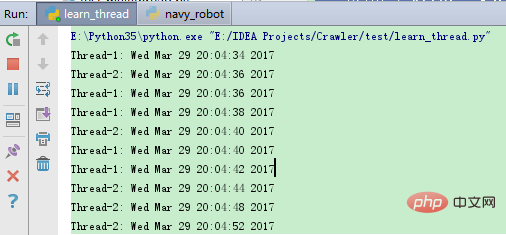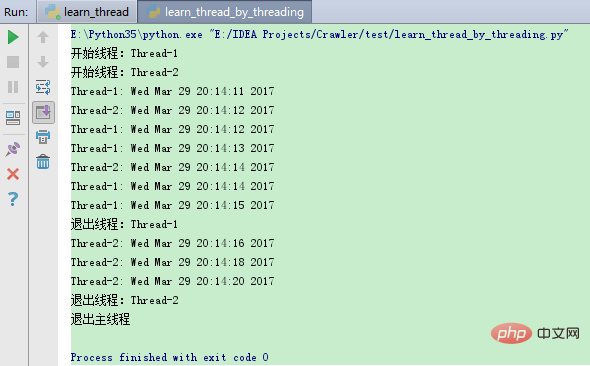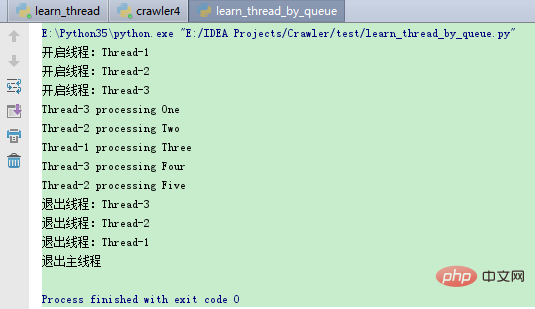帶你一起解讀Python多執行緒

推薦學習:
執行緒講解
多執行緒類似於同時執行多個不同程式,多執行緒執行有如下優點:
- 使用執行緒可以把佔據長時間的程式中的任務放到後臺去處理。
- 使用者介面可以更加吸引人,這樣比如使用者點選了一個按鈕去觸發某些事件的處理,可以彈出一個進度條來顯示處理的進度。
- 程式的執行速度可能加快。
- 在一些等待的任務實現上如使用者輸入、檔案讀寫和網路收發資料等,執行緒就比較有用了。在這種情況下我們可以釋放一些珍貴的資源如記憶體佔用等等。
執行緒在執行過程中與程序還是有區別的。每個獨立的執行緒有一個程式執行的入口、順序執行序列和程式的出口。但是執行緒不能夠獨立執行,必須依存在應用程式中,由應用程式提供多個執行緒執行控制。
每個執行緒都有他自己的一組CPU暫存器,稱為執行緒的上下文,該上下文反映了執行緒上次執行該執行緒的CPU暫存器的狀態。
指令指標和堆疊指標暫存器是執行緒上下文中兩個最重要的暫存器,執行緒總是在程序的上下文中執行的,這些地址都用於標誌擁有執行緒的程序地址空間中的記憶體。
執行緒可以被搶佔(中斷)。
在其他執行緒正在執行時,執行緒可以暫時擱置(也稱為睡眠) – 這就是執行緒的退讓。
執行緒可以分為:
- 核心執行緒:由作業系統核心建立和復原。
- 使用者執行緒:不需要核心支援而在使用者程式中實現的執行緒。
Python3 執行緒中常用的兩個模組為:
- _thread
- threading(推薦使用)
thread 模組已被廢棄。使用者可以使用 threading 模組代替。所以,在 Python3 中不能再使用"thread" 模組。為了相容性,Python3 將 thread 重新命名為 「_thread」。
開始學習Python執行緒
Python中使用執行緒有兩種方式:函數或者用類來包裝執行緒物件。
函數式:呼叫 _thread 模組中的start_new_thread()函數來產生新執行緒。語法如下:
_thread.start_new_thread ( function, args[, kwargs] )
引數說明:
- function - 執行緒函數。
- args - 傳遞給執行緒函數的引數,他必須是個tuple型別。
- kwargs - 可選引數。
範例:
#!/usr/bin/python3
import _thread
import time
# 為執行緒定義一個函數
def print_time( threadName, delay):
count = 0
while count < 5:
time.sleep(delay)
count += 1
print ("%s: %s" % ( threadName, time.ctime(time.time()) ))
# 建立兩個執行緒
try:
_thread.start_new_thread( print_time, ("Thread-1", 2, ) )
_thread.start_new_thread( print_time, ("Thread-2", 4, ) )
except:
print ("Error: 無法啟動執行緒")
while 1:
pass 執行以上程式輸出結果如下:
執行緒模組
Python3 通過兩個標準庫 _thread 和 threading 提供對執行緒的支援。
- _thread 提供了低階別的、原始的執行緒以及一個簡單的鎖,它相比於 threading 模組的功能還是比較有限的。
- threading 模組除了包含 _thread 模組中的所有方法外,還提供的其他方法:
- threading.currentThread(): 返回當前的執行緒變數。
- threading.enumerate():
返回一個包含正在執行的執行緒的list。正在執行指執行緒啟動後、結束前,不包括啟動前和終止後的執行緒。 - threading.activeCount():
返回正在執行的執行緒數量,與len(threading.enumerate())有相同的結果。
除了使用方法外,執行緒模組同樣提供了Thread類來處理執行緒,Thread類提供了以下方法:
- run(): 用以表示執行緒活動的方法。
- start():啟動執行緒活動。
- join([time]): 等待至執行緒中止。這阻塞呼叫執行緒直至執行緒的join()
方法被呼叫中止-正常退出或者丟擲未處理的異常-或者是可選的超時發生。 - isAlive(): 返回執行緒是否活動的。
- getName(): 返回執行緒名。
- setName(): 設定執行緒名。
使用 threading 模組建立執行緒
我們可以通過直接從 threading.Thread 繼承建立一個新的子類,並範例化後呼叫 start() 方法啟動新執行緒,即它呼叫了執行緒的 run() 方法:
#!/usr/bin/python3
import threading
import time
exitFlag = 0
class myThread (threading.Thread):
def __init__(self, threadID, name, counter):
threading.Thread.__init__(self)
self.threadID = threadID
self.name = name
self.counter = counter
def run(self):
print ("開始執行緒:" + self.name)
print_time(self.name, self.counter, 5)
print ("退出執行緒:" + self.name)
def print_time(threadName, delay, counter):
while counter:
if exitFlag:
threadName.exit()
time.sleep(delay)
print ("%s: %s" % (threadName, time.ctime(time.time())))
counter -= 1
# 建立新執行緒
thread1 = myThread(1, "Thread-1", 1)
thread2 = myThread(2, "Thread-2", 2)
# 開啟新執行緒
thread1.start()
thread2.start()
thread1.join()
thread2.join()
print ("退出主執行緒") 以上程式執行結果如下:
執行緒同步
如果多個執行緒共同對某個資料修改,則可能出現不可預料的結果,為了保證資料的正確性,需要對多個執行緒進行同步。
使用 Thread 物件的 Lock 和 Rlock 可以實現簡單的執行緒同步,這兩個物件都有 acquire 方法和 release 方法,對於那些需要每次只允許一個執行緒操作的資料,可以將其操作放到 acquire 和 release 方法之間。如下:
多執行緒的優勢在於可以同時執行多個任務(至少感覺起來是這樣)。但是當執行緒需要共用資料時,可能存在資料不同步的問題。
考慮這樣一種情況:一個列表裡所有元素都是0,執行緒"set"從後向前把所有元素改成1,而執行緒"print"負責從前往後讀取列表並列印。
那麼,可能執行緒"set"開始改的時候,執行緒"print"便來列印列表了,輸出就成了一半0一半1,這就是資料的不同步。為了避免這種情況,引入了鎖的概念。
鎖有兩種狀態——鎖定和未鎖定。每當一個執行緒比如"set"要存取共用資料時,必須先獲得鎖定;如果已經有別的執行緒比如"print"獲得鎖定了,那麼就讓執行緒"set"暫停,也就是同步阻塞;等到執行緒"print"存取完畢,釋放鎖以後,再讓執行緒"set"繼續。
經過這樣的處理,列印列表時要麼全部輸出0,要麼全部輸出1,不會再出現一半0一半1的尷尬場面。
範例:
#!/usr/bin/python3
import threading
import time
class myThread (threading.Thread):
def __init__(self, threadID, name, counter):
threading.Thread.__init__(self)
self.threadID = threadID
self.name = name
self.counter = counter
def run(self):
print ("開啟執行緒: " + self.name)
# 獲取鎖,用於執行緒同步
threadLock.acquire()
print_time(self.name, self.counter, 3)
# 釋放鎖,開啟下一個執行緒
threadLock.release()
def print_time(threadName, delay, counter):
while counter:
time.sleep(delay)
print ("%s: %s" % (threadName, time.ctime(time.time())))
counter -= 1
threadLock = threading.Lock()
threads = []
# 建立新執行緒
thread1 = myThread(1, "Thread-1", 1)
thread2 = myThread(2, "Thread-2", 2)
# 開啟新執行緒
thread1.start()
thread2.start()
# 新增執行緒到執行緒列表
threads.append(thread1)
threads.append(thread2)
# 等待所有執行緒完成
for t in threads:
t.join()
print ("退出主執行緒") 執行以上程式,輸出結果為:
執行緒優先順序佇列(Queue)
Python 的 Queue 模組中提供了同步的、執行緒安全的佇列類,包括FIFO(先入先出)佇列Queue,LIFO(後入先出)佇列LifoQueue,和優先順序佇列 PriorityQueue。
這些佇列都實現了鎖原語,能夠在多執行緒中直接使用,可以使用佇列來實現執行緒間的同步。
Queue 模組中的常用方法:
- Queue.qsize() 返回佇列的大小
- Queue.empty() 如果佇列為空,返回True,反之False
- Queue.full() 如果佇列滿了,返回True,反之False
- Queue.full 與 maxsize 大小對應
- Queue.get([block[, timeout]])獲取佇列,timeout等待時間
- Queue.get_nowait() 相當Queue.get(False)
- Queue.put(item) 寫入佇列,timeout等待時間
- Queue.put_nowait(item) 相當Queue.put(item, False)
- Queue.task_done() 在完成一項工作之後,Queue.task_done()函數向任務已經完成的佇列傳送一個訊號
- Queue.join() 實際上意味著等到佇列為空,再執行別的操作
範例:
#!/usr/bin/python3
import queue
import threading
import time
exitFlag = 0
class myThread (threading.Thread):
def __init__(self, threadID, name, q):
threading.Thread.__init__(self)
self.threadID = threadID
self.name = name
self.q = q
def run(self):
print ("開啟執行緒:" + self.name)
process_data(self.name, self.q)
print ("退出執行緒:" + self.name)
def process_data(threadName, q):
while not exitFlag:
queueLock.acquire()
if not workQueue.empty():
data = q.get()
queueLock.release()
print ("%s processing %s" % (threadName, data))
else:
queueLock.release()
time.sleep(1)
threadList = ["Thread-1", "Thread-2", "Thread-3"]
nameList = ["One", "Two", "Three", "Four", "Five"]
queueLock = threading.Lock()
workQueue = queue.Queue(10)
threads = []
threadID = 1
# 建立新執行緒
for tName in threadList:
thread = myThread(threadID, tName, workQueue)
thread.start()
threads.append(thread)
threadID += 1
# 填充佇列
queueLock.acquire()
for word in nameList:
workQueue.put(word)
queueLock.release()
# 等待佇列清空
while not workQueue.empty():
pass
# 通知執行緒是時候退出
exitFlag = 1
# 等待所有執行緒完成
for t in threads:
t.join()
print ("退出主執行緒") 以上程式執行結果:
推薦學習:
以上就是帶你一起解讀Python多執行緒的詳細內容,更多請關注TW511.COM其它相關文章!